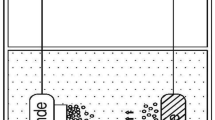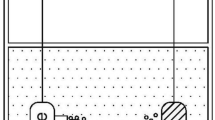Abstract
The rapid latent heat transfer in boiling heat transfer directs its potential use in a variety of heat transfer devices. A new four-step electrodeposition technique is recommended for the development of the micro–nanostructured surface of Cu–Al2O3 nanoparticles (higher thermal conductive) to increase pool boiling heat transfer performance. The nanoparticles deposited at lower current density have increased the nucleation density and the two-step sintering has improved the physical properties of deposited nanoparticles. Thus, apart from cost effectiveness, reliability, and simplicity, the electrodeposition method is able to provide more stable micro–nanostructured surface. Therefore, the method offered in this work is a proficient method for the development of micro–nanostructured surfaces. After carrying out the surface characterization of structured surfaces, the boiling heat transfer performance is studied through experimentations. The influence of different parameters on pool boiling heat transfer (PBHT) enhancement is also analyzed. Based on the study of the achieved results, it is inferred that the fabricated micro–nanostructured surfaces are uniform in structure, achieve higher critical heat flux (92 %), and PBHT coefficient (6.1 times). Thus, the proposed heating surfaces may be considered as a prospective candidate for the cooling of microelectronics devices.














Similar content being viewed by others
Data Availability
Data and materials will be provided on request.
Abbreviations
- A cs :
-
Heating surface area, m2
- h :
-
Heat transfer coefficient, kW·m−2·K−1
- I :
-
Current, A
- k :
-
Thermal conductivity, W·m−1·K−1
- q :
-
Heat flux, kW·m−2
- T f :
-
Working fluid temperature, K
- T s :
-
Heating surface temperature, K
- ΔT :
-
Wall superheat temperature, K
- V :
-
Voltage, V
- Δx :
-
Vertical distance between two thermocouples position
References
D.E. Kim, D.I. Yu, D.W. Jerng, M.H. Kim, H.S. Ahn, Review of boiling heat transfer enhancement on micro/nanostructured surfaces. Exp. Therm. Fluid Sci. 66, 173–196 (2015)
M. Shojaeian, A. Kosar, Pool boiling and flow boiling on micro- and nanostructured surfaces. Exp. Therm. Fluid Sci. 63, 45–73 (2015)
A.K.M.M. Morshed, T.C. Paul, J. Khan, Effect of Cu–Al2O3 nanocomposite coating on flow boiling performance of a microchannel. Appl. Therm. Eng. 51, 1135–1143 (2013)
K.N. Rainey, S.M. You, Effect of heater size and orientation on pool boiling heat transfer from microporous coated surfaces. Int. J. Heat Mass Transf. 44, 2589–2599 (2001)
B.J. Jones, J.P. McHale, S.V. Garimella, The influence of surface roughness on nucleate pool boiling heat transfer. J. Heat Transf. 131, 121009 (2009)
J.J. Wei, H. Honda, Effects of fin geometry on boiling heat transfer from silicon chips with micro-pin-fins immersed in FC-72. Int. J. Heat Mass Transf. 46, 4059–4070 (2003)
S.K. Gupta, R.D. Misra, An experimental investigation on pool boiling heat transfer enhancement using Cu–Al2O3 nano-composite coating. Exp. Heat Transf. 32, 133–158 (2019)
X. Zheng, C.W. Park, Experimental study of the sintered multi-walled carbon nanotube/copper microstructures for boiling heat transfer. Appl. Therm. Eng. 86, 14–26 (2015)
S.S. Hsieh, C.J. Weng, Nucleate pool boiling from coated surfaces in saturated R-134a and R-407c. Int. J. Heat Mass Transf. 40, 519–532 (1997)
S. Das, D.S. Kumar, S. Bhaumik, Experimental study of nucleate pool boiling heat transfer of water on silicon oxide nanoparticle coated copper heating surface. Appl. Therm. Eng. 96, 555–567 (2016)
C. Li, G.P. Peterson, Parametric study of pool boiling on horizontal highly conductive microporous coated surfaces. J. Heat Transf. 129, 1465–1475 (2007)
Z.G. Xu, C.Y. Zhao, Experimental study on pool boiling heat transfer in gradient metal foams. Int. J. Heat Mass Transf. 85, 824–829 (2015)
C. Li, Z. Wang, P.I. Wang, Y. Peles, N. Koratkar, G.P. Peterson, Nanostructured copper interfaces for enhanced boiling. Small 4, 1084–1088 (2008)
Z. Yao, Y.W. Lu, S.G. Kandlikar, Effects of nanowire height on pool boiling performance of water on silicon chips. Int. J. Therm. Sci. 50, 2084–2090 (2011)
Y. Chen, D.C. Mo, H.B. Zhao, N. Ding, S.S. Lu, Pool boiling on the superhydrophilic surface with TiO2 nanotube arrays. Sci. China Ser. E Technol. Sci. 52, 1596–1600 (2009)
K. Nagato, S. Miyazaki, S. Yamada, M. Nakao, Nano/microcomposite surface fabricated by chemical treatment/microembossing for control of bubbles in boiling heat transfer. CIRP Ann. Manuf. Technol. 65, 511–514 (2016)
S.H. Li, R. Furberg, M.S. Toprak, B. Palm, M. Muhammed, Nature-inspired boiling enhancement by novel nanostructured macroporous surfaces. Adv. Funct. Mater. 18, 2215–2220 (2008)
M.S. El-Genk, A.F. Ali, Enhanced nucleate boiling on copper micro-porous surfaces. Int. J. Multiph. Flow 36, 780–792 (2010)
C.M. Patil, K.S.V. Santhanam, S.G. Kandlikar, Development of a two-step electrodeposition process for enhancing pool boiling. Int. J. Heat Mass Transf. 79, 989–1001 (2014)
P.F. Xu, Q. Li, Y.M. Xuan, Enhanced boiling heat transfer on composite porous surface. Int. J. Heat Mass Transf. 80, 107–114 (2015)
Y.Q. Wang, D.C. Mo, S.S. Lyu, Enhanced pool boiling heat transfer on mono and multi-layer micro–nano bi-porous copper surfaces, in Proceedings of the ASME 5th International Conference on Micro/Nanoscale Heat and Mass Transfer, Singapore (2016)
A. Jaikumar, S.G. Kandlikar, Ultra-high pool boiling performance and effect of channel width with selectively coated open microchannels. Int. J. Heat Mass Transf. 95, 795–805 (2016)
Y.-Q. Wang, S.-S. Lyu, J.-L. Luo, Z.-Y. Luo, Y.-X. Fu, Y. Heng, J.-H. Zhang, D.-C. Mo, Copper vertical micro dendrite fin arrays and their superior boiling heat transfer capability. Appl. Surf. Sci. 422, 388–393 (2017)
L.N. Dong, X.J. Quan, P. Cheng, An experimental investigation of enhanced pool boiling heat transfer from surfaces with micro/nano-structures. Int. J. Heat Mass Transf. 71, 189–196 (2014)
W. Fritz, Maximum volume of vapor bubbles. Phys. Z. 36, 379–384 (1935)
H.T. Phan, N. Caney, P. Marty, S. Colasson, J. Gavillet, Surface wettability control by nanocoating: the effects on pool boiling heat transfer and nucleation mechanism. Int. J. Heat Mass Transf. 52, 5459–5471 (2009)
A.R. Betz, J. Xu, H.H. Qiu, D. Attinger, Do surfaces with mixed hydrophilic and hydrophobic areas enhance pool boiling? Appl. Phys. Lett. 97, 3 (2010)
X.M. Dai, X.Y. Huang, F.H. Yang, X.D. Li, J. Sightler, Y.C. Yang, C. Li, Enhanced nucleate boiling on horizontal hydrophobic-hydrophilic carbon nanotube coatings. Appl. Phys. Lett. 102, 5 (2013)
H. Jo, D.I. Yu, H. Noh, H.S. Park, M.H. Kim, Boiling on spatially controlled heterogeneous surfaces: wettability patterns on microstructures. Appl. Phys. Lett. 106, 5 (2015)
M. Zupančič, M. Steinbucher, P. Gregorcic, I. Golobic, Enhanced pool-boiling heat transfer on laser-made hydrophobic/superhydrophilicpolydimethylsiloxane-silica patterned surfaces. Appl. Therm. Eng. 91, 288–297 (2015)
S.K. Gupta, R.D. Misra, Experimental study of pool boiling heat transfer on copper surfaces with Cu–Al2O3 nanocomposite coatings. Int. Commun. Heat Mass Transf. 97, 47–55 (2018)
S.K. Gupta, R.D. Misra, An experimental investigation on flow boiling heat transfer enhancement using Cu–TiO2 nanocomposite coating on copper substrate. Exp. Therm. Fluid Sci. 98, 406–419 (2018)
H. Shin, J. Dong, M. Liu, Nanoporous structures prepared by an electrochemical deposition process. Adv. Mater. 19, 1611–1614 (2003)
S. Li, R. Furberg, M.S. Toprak, B. Palm, M. Muhammed, Nature-inspired boiling enhancement by novel nanostructured macroporous surfaces. Adv. Funct. Mater. 18, 2210–2215 (2008)
J.P. Holman, Experimental Methods for Engineers, 7th edn. (Tata McGraw Hill Education Private Limited, New York, 2007)
W.M. Rohsenow, A method of correlating heat transfer data for surface boiling of liquids. ASME 74, 969–976 (1952)
G. Li, B. Thomas, J. Stubbins, Modeling creep and fatigue of copper alloys. Metall. Mater. Trans. A 31, 2491–2502 (2000)
S.G. Kandlikar, A theoretical model to predict pool boiling CHF incorporating effects of contact angle and orientation. ASME J. Heat Transf. 123, 1071–1079 (2001)
S.G. Kandlikar, Handbook of Phase Change: Boiling and Condensation (CRC Press, Boca Raton, 1999)
A. Bar-Cohen, A. McNeil, Parametric effects on pool boiling critical heat flux in dielectric liquids, in Proceedings of the Engineering Foundation Conference on Pool and External Flow Boiling (ASME, Santa Barbara, 1992)
H.S. Ahn, H.J. Jo, S.H. Kang, M.H. Kim, Effect of liquid spreading due to nano/microstructures on the critical heat flux during pool boiling. Appl. Phys. Lett. 98, 71908 (2011)
S.J. Kim, I.C. Bang, J. Buongiorno, L.W. Hu, Surface wettability change during pool boiling of nanofluids and its effect on critical heat flux. Int. J. Heat Mass Transf. 50, 4105–4116 (2007)
T. Hibiki, M. Ishii, Active nucleation site density in boiling system. Int. J. Heat Mass Transf. 46, 2587–2601 (2003)
N. Basu, G.R. Warrier, V.K. Dhir, Onset of nucleate boiling and active nucleation site density during subcooled flow boiling. ASME J. Heat Transf. 124, 717–728 (2002)
R.J. Benjamin, A.R. Balakrishnan, Nucleation site density in pool boiling of saturated pure liquids: effect of surface microroughness and surface and liquid physical properties. Exp. Therm. Fluid Sci. 15, 32–42 (1997)
S. Kotthoff, D. Gorenflo, E. Danger, A. Luke, Heat transfer and bubble formation in pool boiling: effect of basic surface modifications for heat transfer enhancement. Int. J. Therm. Sci. 45, 217–236 (2006)
A.K. Das, P.K. Das, P. Saha, Performance of different structured surfaces in nucleate pool boiling. Appl. Therm. Eng. 29, 3643–3653 (2009)
P. Griffith, J.D. Wallis, The role of surface conditions in nucleate boiling. The Office of Naval Research, Technical Report No. 14 (1958), pp. 1–16
S.M. Kwark, R. Kumar, G. Moreno, J. Yoo, S.M. You, Pool boiling characteristics of low concentration nanofluids. Int. J. Heat Mass Transf. 53, 972–981 (2010)
A.R. Betz, J. Xu, H. Qiu, D. Attinger, Do surfaces with mixed hydrophilic and hydrophobic areas enhance pool boiling? Appl. Phys. Lett. 97, 141909 (2010)
S. Das, B. Saha, S. Bhaumik, Experimental study of nucleate pool boiling heat transfer of water by surface functionalization with crystalline TiO2 nanostructure. Appl. Therm. Eng. 113, 1345–1357 (2017)
B. Shi, Y.-B. Wang, K. Chen, Pool boiling heat transfer enhancement with copper nanowire arrays. Appl. Therm. Eng. 75, 115–121 (2015)
M.-C. Lu, C.-H. Huang, C.-T. Huang, Y.-C. Chen, A modified hydrodynamic model for pool boiling CHF considering the effects of heater size and nucleation site density. Int. J. Therm. Sci. 91, 133–141 (2015)
Funding
No funding used for this work.
Author information
Authors and Affiliations
Contributions
The experimental work and paper writing are combined contributions from both authors. Both authors have equal contribution in this work.
Corresponding author
Ethics declarations
Conflict of interest
The authors have no conflicts of interest to declare.
Additional information
Publisher's Note
Springer Nature remains neutral with regard to jurisdictional claims in published maps and institutional affiliations.
Rights and permissions
Springer Nature or its licensor (e.g. a society or other partner) holds exclusive rights to this article under a publishing agreement with the author(s) or other rightsholder(s); author self-archiving of the accepted manuscript version of this article is solely governed by the terms of such publishing agreement and applicable law.
About this article
Cite this article
Gupta, S.K., Misra, R.D. Experimental Pool Boiling Heat Transfer Analysis with Copper–Alumina Micro/Nanostructured Surfaces Developed by a Novel Electrochemical Deposition Technique. Int J Thermophys 44, 112 (2023). https://doi.org/10.1007/s10765-023-03218-x
Received:
Accepted:
Published:
DOI: https://doi.org/10.1007/s10765-023-03218-x




